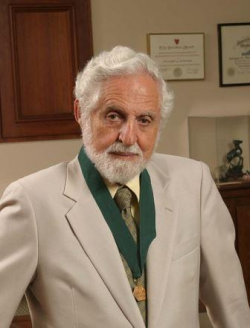Carl Djerassi

Image courtesy of the Chemical Heritage Foundation
- Born
- 29 October 1923
- Died
- 30 January 2015 (age 91)
Carl Djerassi played a key role in the development of the birth control pill and antihistamines. The pill radically transformed women’s lives and is seen as a key milestone in social, as well as biomedical, history.
Djerassi was born to a Jewish mother in Vienna and then grew up in Bulgaria. He and his mother escaped the Nazis and moved to America in 1939, arriving in their country almost penniless. He went on to study at Kenyon College and graduated before his nineteenth birthday.
From the 1940s, he helped to synthesize the first commercial antihistamines and topical corticosteroids, which are used to treat allergies and inflammation.
Djerassi was leading a research team in Mexico City when they synthesized the substance that became used in contraceptive pills. They had actually been researching something different. They were using yams, grown locally, to produce cortisone. This was part of a search for a new drug for arthritis.
At that time, the supply of cortisone came from slaughterhouse animals, and was expensive and difficult to get hold of. Djerassi decided to use diosgenin for partial synthesis and discovered that it could also be sued to synthesise the female sex hormone progestogen. The team later synthesized norethisterone, that became used in the first commercially available contraceptive pill.
Djerassi sent the substance to a number of endocrinologists including Gregory Pincus. Pincus found that it worked on animals and a further small-scale study in 1954 by John Rock at Harvard found that it worked on humans as well. Rock’s study was confirmed by a much larger trial, organised by Pincus, in 1956. Envoid, the first birth control pill, was licenced for use in 1960.
In his book, This Mans Pill, Djerassi said he thought that the pill had been developed in the technological postwar euphoria and he did not think it would have been created today. He also believed that the sexual revolution of the 1960s would not have happened without the pill.
one of the most productive chemists of his time – a developer of antihistamines, a founder of biomedical companies, a teacher of world-class chemists and a novelist
There were many other achievements in Djerassi’s life. He published more than 1200 papers which helped to transform the way that chemists worked. He also made advances in understanding how nature makes molecules known as biosysnthesis. In 1965 he and a colleague Edward Feigenbaum devised a computer programme that predicted the structure of unknown organic compounds.
Aside from science, Djerassi began writing fiction in the 1990s, illustrating the personal conflicts and moral dilemmas that scientists face in their work. He founded an artists’ colony in California that has hosted more than 2000 artists.
Djerassi received many awards including America’s National Medal of Science and the National Medal of Technology and Innovation.



